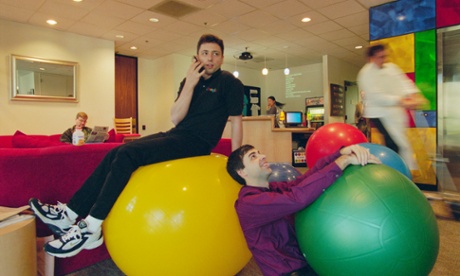
How can I stay healthy when I sit at a desk all day?
“If you feel chained to a PC or desk then try standing, make phone calls walking round the office or go for a walk and use a mobile,” advises Dr John Giles, medical director at Benenden and an NHS consultant radiologist. “We can all increase our activity when working or commuting with simple measures such as avoiding lifts, walking more, cycling to work and getting off the bus or tube one extra stop away.”
Charlotte Ord, owner of health and fitness club Charlotte Ord Academy, recommends using a standing desk. “With a few simple set up adjustments (ie table height) you can really reduce the negative impact of sitting for hours on your posture, back and neck.”
As an alternative, she advises sitting on a stability ball instead of a chair, which will help activate your core and prevent too much slumping. “You can also use it in your breaks for a few exercises. You can work pretty much every muscle group with a stability ball.”
How can I make the most of my lunch break?
Lunch breaks are important to keeping motivated throughout the day, says Catherine Lloyd, a stress management coach for Make The Change. They keep energy levels up and are a time for reflection and help develop a good mindset for the afternoon, she adds.
“It is also good to get outside and take a walk however short it might be. This will help clear the mind, [allow you to] breathe in some different surroundings and if you have a nagging problem you might find you will be able to solve that at the same time. It can also become a social time if you invite other people along with you.”
Any advice on becoming more active in the office?
Ord says it’s important is to get up and moving as much as possible throughout the day. “Exercise before work and walk or cycle in if feasible. Get outside during your lunch break and take calls while standing.”
Sarah Archer, a career coach and co-founder of CareerTree, advises workers to do one thing differently every day in order to change sedentary patterns. She recommends speaking face to face instead of sending an email, walking the stairs instead of taking the lift and suggests standing up in the next team meeting.
Dr Adam Al-Kashi, head of research and education for BackCare, the UK’s national back pain charity in support of active working, echoes Archer’s view.
“Think creatively about building frequent movement variety into your day. This might involve getting a few bits of kit. For example, I have a pull-up bar at work. Equally it can just include finding excuses or reasons to stand more and walk about more – take calls roving, read paper documents standing.”
How do I make the move into an active career if I have no qualifications or experience?
“If you have a ‘can do’ positive outlook and you are willing to learn, you’ll be surprised how far this can take you,” says Lucy Whitehall, a wellbeing consultant for CABA, which specialises in employee wellbeing and work environments. “Don’t be afraid to contact organisations directly, find out who the hiring managers are and get yourself known to them.”
Ord recommends gaining as much work experience as possible in the areas that interest you.
“Employers like me are often far more interested in taking people on who are hard working, reliable and passionate about the job than just qualifications and will support you in getting trained up if you prove to be a great prospect.”
Archer believes volunteering can be a great way to get experience in the sector you want to work in and also to discover if it’s the right work for you. “It also gives you the opportunity to meet other people interested in the kind of things you are interested in and so you can start to build a network which could be useful for hearing about opportunities and getting advice.”
I sit at a desk and often suffer from back pain. What are the best ways to help prevent it?
Firstly make sure your desk and PC are set to the right height and you’re sitting in a correctly adjusted ergonomic chair or on a swiss ball, says Ord. “Regularly stretching your hip flexors and quads will help to prevent shortening of these muscles and associated anterior pelvic tilt and back pain. Similarly, getting a reputable rehab specialist to show you exercises to correct or prevent forward head position and kyphosis will help to protect your upper back and neck and associated headaches.”
Lloyd suggests taking a lap of the office when you make a drink and doing some flexibility exercises first thing in the morning or as part of your cooling down regime after you have exercised.
Looking for a job? Browse Guardian Jobs or sign up to Guardian Careers for the latest job vacancies and career advice.

